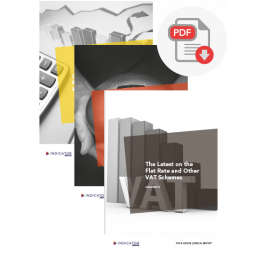Our exclusive package of 3 tax-saving Special Reports
Special package deal
-
 The Latest on the Flat Rate and Other VAT Schemes (PDF)
The Latest on the Flat Rate and Other VAT Schemes (PDF)
-
 Maximising Your Pension Fund (PDF)
Maximising Your Pension Fund (PDF)
-
 Directors' Loan Accounts - Making the Tax Rules Work for You (PDF)
Directors' Loan Accounts - Making the Tax Rules Work for You (PDF)
A Tips & Advice Special Report about...
In a nutshell
This Special Report brings together key information about VAT schemes. It explains who the schemes are for, how they work as well as their pros and cons. You’ll learn how to fully exploit the VAT schemes to minimise admin and even reduce your VAT bill.
In detail
Navigating the VAT legislation is a minefield. However, there are special schemes that can reduce costs and even save you money.
This Special Report tells you what schemes are available and how to use them to your advantage. It provides you with the latest information on:
- Voluntary schemes such as the flat rate, annual accounting, retail and many more
- Mandatory schemes such as the capital goods
- Which schemes you can or must use
- How to join and leave a scheme
- The pros and cons of each
In simple language and with clear examples, this Special Report explains how to make the most of VAT schemes to minimise admin and save time and money.
We've created this Tips & Advice Special Report especially for...
Everyone in business plus VAT advisors that want to:
- Know how to make the most of the available VAT schemes
You'll get the following free extras with this Tips & Advice Special Report...
An online service with ready-to-use documents
- To immediately apply our advice and solutions in practice
- That you can easily adapt to suit your own requirements
A Tips & Advice Special Report about...
In a nutshell
This Special Report helps you maximise the value of your pension fund. It covers the latest pension rules including pension annual allowance tapering and how they affect your pension scheme. It also offers a host of ideas to get the most out of your pension savings. Whatever your situation, this Special Report ensures your efforts to build up your pension fund are properly rewarded through effective tax planning.
In detail
With so many changes to the pension rules over recent years, it’s difficult to keep up. This Special Report brings you quickly up to speed and answers important questions such as:
- Which different types of pension exist?
- How do you make cost-effective pension contributions?
- What are the options to withdraw money from your fund tax-efficiently?
- What are effective tax planning strategies?
This Special Report, crammed with useful advice, will help you keep more money in your retirement pocket and out of HMRC’s.
We've created this Tips & Advice Special Report especially for...
Business owners, company directors and anyone with a pension that wants to:
- Know which pension schemes work best in their situation
- Build up a pension fund in a safe and tax-effective way
- Get the most from future pension savings
Financial advisors and accountants that want to:
- Be aware of all the complicated pension rules scheme for their clients
You'll get the following free extras with this Tips & Advice Special Report...
An online service with ready-to-use documents
- To immediately apply our advice and solutions in practice
- That you can easily adapt to suit your own requirements
You can choose from the following options...
Digital
- The PDF-version
- Delivered to your inbox
Take a look at your options below.
A Tips & Advice Special Report about...
In a nutshell
This Special Report provides you with ready-to-apply solutions to deal with the tricky loan account rules. It explains how to manage loan account transactions in the most tax-efficient ways.
In detail
In plain English, this Special Report covers:
- Loan-related tax charges
- What the different tax charges are
- When the s.455 charge applies to companies
- When the benefit in kind charge applies to directors
- What "conferring a benefit" on a participator means
- Reporting to HMRC
- When you need to tell HMRC about the loan
- How to report loan account transactions
- How to account for s.455 tax
- Avoiding the tax charges
- How and when to repay or clear a loan
- What the repayment options are
- Optimising your tax-planning strategy
Transactions between directors and their companies have always been a prime target for HMRC, and the rules have become increasingly complicated, making tax charges difficult to avoid. This Special Report offers you a series of legitimate ways to avoid tax. It's outstanding value for money.
We've created this Tips & Advice Special Report especially for...
Company directors that want to:
- Manage their loan account transactions in a tax-efficient way
Tax advisors and accountants that want to:
- Determine the best tax-saving strategy for their clients
You'll get the following free extras with this Tips & Advice Special Report...
An online service with ready-to-use documents
- To immediately apply our advice and solutions in practice
- That you can easily adapt to suit your own requirements
You can choose from the following options...
Digital
- The PDF-version
- Delivered to your inbox
Take a look at your options below.



 (01233) 653500
(01233) 653500 






